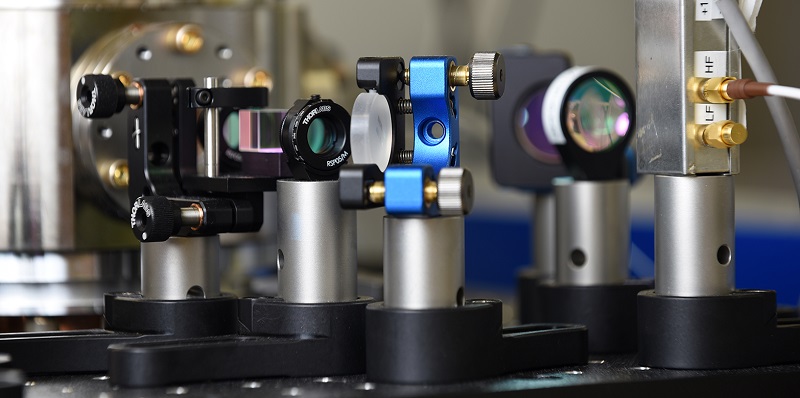A Swiss research project has shown that high-precision reference signals can be sent via conventional telecommunications infrastructure. The project, part of the Swiss National Science Foundation’s Synergia program, involves researchers from ETH Zurich, the University of Basel, the Swiss Federal Institute of Metrology (METAS), and the SWITCH Foundation, which operates Switzerland’s academic data network.
“Initial results show that this permits chemical spectroscopy analyses that are 100 times more accurate than before,” Stefan Willitsch, professor of physical chemistry at the University of Basel and coordinator of the project, said of the work.
“With this precision, the laws of nature are verified by spectroscopic measurements on molecules with unprecedented accuracy,” added Frédéric Merkt, professor of physical chemistry at ETH Zurich.

Close-up of the optical components used to stabilize the light of the infrared laser for the precise reference frequency. Courtesy of METAS.
The project established a trial network that connects the METAS site in Wabern with the University of Basel and ETH Zurich. The output signal is synchronized with the METAS atomic clock and is transmitted via the fiber optic network operated by SWITCH. The signal is sent to Basel and Zurich where researchers can use it to calibrate their measuring devices.
“To ensure that the signal reaches the researchers with the desired level of precision, transmission must be continuously adjusted. Even the slightest variation in the length of the fiber optic cable — caused by vibrations or temperature changes — affect the frequency,” said Jacques Morel, head of the Photonics, Time, and Frequency Laboratory at METAS.
To remedy this, the signal is bounced back from Basel and Zurich to Bern, where the output signal is corrected as required.
Jérôme Faist, a professor at the Institute for Quantum Electronics at ETH Zurich who is credited with a central role in the creation of the quantum cascade laser, contributed laser expertise to the project. “In Switzerland, we're only now beginning to establish this kind of network,” he said. “Other countries like Italy, Germany, and France are already a step ahead in this area.”

In these countries, the reference frequencies have, up to now, been transmitted in one of two ways, each with its own specific drawbacks. Either the signal is sent using a dedicated cable, which produces an optimum physical result, but carries significant cost. The other method transmits the signal via the telecommunication provider’s existing infrastructure, which is significantly cheaper, though it is technically inferior as the reference signal for measuring time is transmitted in the C band. In other words, it is transmitted at a similar frequency to data traffic, which leaves it open to potential disruption and blocks a channel that would ordinarily be used for data transmission, which complicates operation.
“We’ve now developed a third option,” said Fabian Mauchle, project manager at SWITCH. “For reasons of cost, we use the existing SWITCH network. But instead of transmitting the reference signal within the physically optimum C band — which is largely taken up by data traffic — we use the L band, which is still mostly uncongested and has a different base frequency.”
The results show that the L band is also a viable option for transmitting reference signals at excellent quality without disruption from data traffic. This did, however, require SWITCH to make certain modifications to its network infrastructure.
The next step will be to further expand the network to include other Swiss institutions, and there are plans to take the network to an international level by establishing a transnational network capable of comparing signal from various atomic clocks. This would pave the way for a more precise time measurement for defining the second as an SI unit.
To ensure consistent time measurement worldwide, atomic clocks are currently compared with satellite signals in the gigahertz range. Synchronizing atomic clocks using optical signals in the terahertz range would allow measurements of the second up to 18 decimal places, compared to the 16 decimal places previously achieved.
The only way this can work is if the signals used to compare these optical clocks are transmitted as light via fiber optics.
The research was published in Optics Express (www.doi.org/10.1364/OE.427921).